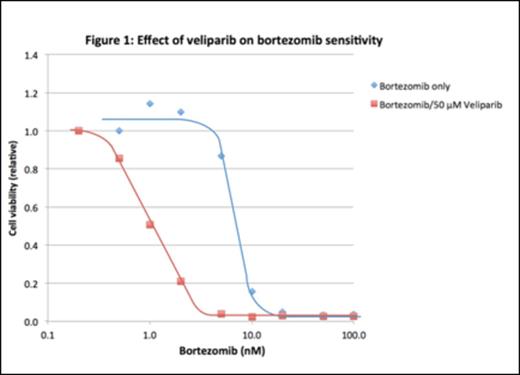Abstract
One hallmark of multiple myeloma is its genetic instability, leading to extensive molecular heterogeneity. This has led to the hypothesis that a high level of DNA repair is needed to counterbalance the continual genotoxic stress seen in these cells. One important DNA repair pathway involves PARP (poly-ADP ribose polymerase 1 and 2). With the goal of developing improved therapies against myeloma, we examined for potential synergy between the PARP inhibitor veliparib and agents currently used to treat myeloma.
In these pre-clinical studies, various myeloma cell lines including OPM2.2 and RPMI 8226 are being tested. Cells in triplicate are exposed to myeloma therapeutics (e.g., bortezomib, doxorubicin, cyclophosphamide) in the presence and absence of a sub-lethal dose of veliparib. Cells are incubated for 48 h and viability then assayed by luminescence using CellTiter-Glo (Promega).
Dependent on the cell line, we found that veliparib can be synthetically lethal with other agents. For example, testing OPM2.2 cells, we found that 50 µM veliparib caused a ~7-fold decrease in the bortezomib LC50 from 7.1 nM (bortezomib alone) to 1.0 nM (bortezomib and veliparib; see Figure). We note that the concentration of veliparib employed was significantly below the LC50 of veliparib (410 µM) for these same OPM2.2 cells. In contrast, RPMI 8226 cells did not show a significant synergy between bortezomib and veliparib, even though the LC50 of each agent alone was similar to that found for OPM2.2 cells.
We are currently examining the synergy between veliparib and other chemotherapeutic agents and additional myeloma cell lines. These studies will determine the generality of a potential synthetic lethality between these agents, and reveal whether use of a PARP inhibitor has the potential to provide improved treatment options against myeloma.
No relevant conflicts of interest to declare.
Author notes
Asterisk with author names denotes non-ASH members.


